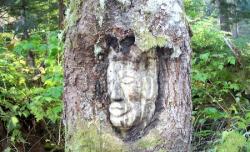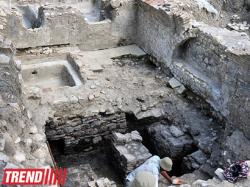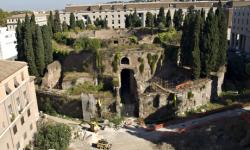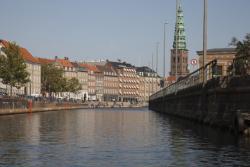INSTITUT SUPERIEUR D'ANTHROPOLOGIE
INSTITUTE OF ANTHROPOLOGY
ONLINE COURSES / COURS A DISTANCE
SPRING TERM : APRIL 2014
REGISTER NOW
CANADA –  Toba Inlet - A face carved into a tree trunk was discovered by forestry workers in a remote location up Toba Inlet. It had been staring down an ancient river valley in the rainforest for almost 200 years.The recent chance discovery was made approximately 60 miles up the inlet and helped to silence a question of doubt regarding the geographic limits of Klahoose First Nation traditional territory.The Klahoose discovery went a long way toward silencing reason of doubt from the federal government concerning the extent of Klahoose traditional land. “The area was known to be in Klahoose territory,” Francis said. “It has filled gaps in history for us. There was a strength of claim done against Klahoose a few years ago. We would argue the inlets, the lower reaches of the valleys and the river beds. The government would argue against it.”n addition to marking the traditional territory of first nations that once used this technique, anthropologist Franz Boas wrote that he believed such carvings may also have been used to mark ownership of specific trees intended to be used in construction or boat building. Once ownership was emblazoned on the side of the tree it could then be traded or preserved and harvested at a later date.
Toba Inlet - A face carved into a tree trunk was discovered by forestry workers in a remote location up Toba Inlet. It had been staring down an ancient river valley in the rainforest for almost 200 years.The recent chance discovery was made approximately 60 miles up the inlet and helped to silence a question of doubt regarding the geographic limits of Klahoose First Nation traditional territory.The Klahoose discovery went a long way toward silencing reason of doubt from the federal government concerning the extent of Klahoose traditional land. “The area was known to be in Klahoose territory,” Francis said. “It has filled gaps in history for us. There was a strength of claim done against Klahoose a few years ago. We would argue the inlets, the lower reaches of the valleys and the river beds. The government would argue against it.”n addition to marking the traditional territory of first nations that once used this technique, anthropologist Franz Boas wrote that he believed such carvings may also have been used to mark ownership of specific trees intended to be used in construction or boat building. Once ownership was emblazoned on the side of the tree it could then be traded or preserved and harvested at a later date.
http://www.prpeak.com/articles/2014/04/02/news/doc533b5469620d6339557080.txt
AZERBAIDJAN / GEORGIE –  Sud Caucase - Azerbaijani archeologists will cooperate with German and Georgian collegues. A memorandum on cooperation was signed on complex research on paleometallurgy and Early Bronze Age ceramics of the South Caucasus among the Institute of Archaeology and Ethnography of the Azerbaijan National Academy of Sciences, German Mining Museum Bochum and the National Museum of Georgia. Arheo metallurgy field research expeditions will be held with the organizational supported by the Bochum Museum, particularly in the western regions of Azerbaijan and eastern regions of Georgia in the South Caucasus in 2014-2016, according to the memorandum. In accordance with the agreement, the samples of the paleometallurgy and ceramics taken from the museum collections will be analyzed in the leading research laboratories in Germany. Training on paleometallurgy and ancient pottery will be conducted in Germany in the framework of cooperation for training and specialization of young cadres from Azerbaijan and Georgia on a permanent basis. The research results will be presented at international scientific conferences, which will be held in Baku and Tbilisi in 2016.
Sud Caucase - Azerbaijani archeologists will cooperate with German and Georgian collegues. A memorandum on cooperation was signed on complex research on paleometallurgy and Early Bronze Age ceramics of the South Caucasus among the Institute of Archaeology and Ethnography of the Azerbaijan National Academy of Sciences, German Mining Museum Bochum and the National Museum of Georgia. Arheo metallurgy field research expeditions will be held with the organizational supported by the Bochum Museum, particularly in the western regions of Azerbaijan and eastern regions of Georgia in the South Caucasus in 2014-2016, according to the memorandum. In accordance with the agreement, the samples of the paleometallurgy and ceramics taken from the museum collections will be analyzed in the leading research laboratories in Germany. Training on paleometallurgy and ancient pottery will be conducted in Germany in the framework of cooperation for training and specialization of young cadres from Azerbaijan and Georgia on a permanent basis. The research results will be presented at international scientific conferences, which will be held in Baku and Tbilisi in 2016.
http://en.trend.az/news/society/2258461.html
SOUDAN - Jebel Barkal - Three statues linked to royal burial ceremonies in Sudan's ancient Napatan civilisation have been stolen from a museum near a UNESCO World Heritage site, an official said today. Their disappearance underscores the lack of protection afforded Sudan's rich but under-developed archaeological heritage. "They are small statues, about 10-15 centimetres high (4-6 inches) but it's very significant because the Napatan kingdom is one of the important periods in Sudanese history," Abdurrahman Ali, head of the country's museums, told AFP. He said the statues, dating from 450 BC, disappeared from a small museum at the Jebel Barkal heritage area in northern Sudan.
http://www.business-standard.com/article/pti-stories/ancient-statues-stolen-from-sudan-heritage-site-114040200050_1.html
USA –  Switchback - Archaeologist Shanna Diederichs and her team have figured out that a series of dwellings in the area called the Switchback site marks the beginning of a more permanent settlement for Ancestral Puebloan culture from 500-750 AD. “The data shows this is when settlements began to focus on larger-scale agriculture. It is a transitioning period from mostly hunting and gathering to a farming society that supports a permanent community year-round,” she says. Groups of pit dwellings appear to be used as workhouses where early farmers escaped the heat, stored tools and grain, and grabbed a bite before returning to the fields. Sound familiar? Local farming roots go back millennia, attracted by nutrient-rich red soils and sunny climate that continue to produce crops today. Pottery sherds at Switchback are more basic early designs, lacking the black-on-white style and creativity associated with vessels from later, more established settlements that had more free time. Geophysical surveys by the PBS archaeology series Time Team America helped to pinpoint where to dig to reveal the dwellings and mysteries of the pre-Colombian societies at Indian Camp. “Here we’re seeing a new era, the beginning of the agricultural economy, and the end of the Neolithic,” Diederichs says.
Switchback - Archaeologist Shanna Diederichs and her team have figured out that a series of dwellings in the area called the Switchback site marks the beginning of a more permanent settlement for Ancestral Puebloan culture from 500-750 AD. “The data shows this is when settlements began to focus on larger-scale agriculture. It is a transitioning period from mostly hunting and gathering to a farming society that supports a permanent community year-round,” she says. Groups of pit dwellings appear to be used as workhouses where early farmers escaped the heat, stored tools and grain, and grabbed a bite before returning to the fields. Sound familiar? Local farming roots go back millennia, attracted by nutrient-rich red soils and sunny climate that continue to produce crops today. Pottery sherds at Switchback are more basic early designs, lacking the black-on-white style and creativity associated with vessels from later, more established settlements that had more free time. Geophysical surveys by the PBS archaeology series Time Team America helped to pinpoint where to dig to reveal the dwellings and mysteries of the pre-Colombian societies at Indian Camp. “Here we’re seeing a new era, the beginning of the agricultural economy, and the end of the Neolithic,” Diederichs says.
http://www.cortezjournal.com/article/20140331/NEWS01/140339978/Indian-Camp-Ranch-continues-to-amaze-
ITALIE –  Rome - He was Rome's first emperor, the founder of a world-dominating imperial dynasty, and a builder of roads and stunning temples who brought peace to a far-flung empire; a man so powerful the Roman senate named a month after him. Now, on the 2,000th anniversary of the death of the emperor Augustus, the city of Rome is getting ready to honour its favourite son by saving his mausoleum from shocking neglect. Built in 28BC and as broad as a city block, the cylindrical mausoleum has seen better days after being sacked, bombed and built upon down the centuries. It was used as a bullfighting ring and a concert hall before it was finally abandoned, recently becoming a hangout for prostitutes and a handy toilet for tramps. That was a sad fate for one of Rome's most significant and sacred monuments, which once stood 120ft high – topped by a 15ft bronze statue of Augustus – and housed the emperor's ashes as well as those of his successors Tiberius and Claudius. Today, as tourists flock to the Forum and the Colosseum, diners at the pizzeria across the street from Augustus's mausoleum – which lurks behind a fence in a piazza yards from Via del Corso – barely notice it.Augustus made Rome the world's biggest and most beautiful city, the capital for business, culture and entertainment," said Rome's culture assessor, Flavia Barca. "Not every city can celebrate a 2,000-year anniversary." Considered to be Rome's finest emperor, Augustus defeated his rivals Antony and Cleopatra before establishing Pax Romana throughout the empire, while rebuilding Rome and setting up the city's first police and fire fighting services, claiming on his death bed: "I found a Rome of bricks; I leave to you one of marble".;;The marble has long been stripped from his mausoleum, but three concentric outer walls, the widest 15ft thick and the highest 50ft tall, have stood the test of time, while an upper floor is now missing, leaving a surprisingly large open-air circular space inside where the horns and screeches of Rome's thundering traffic fade to an eerie silence.Pillaged in 410 by Visigoths who scattered the emperors' ashes, the mausoleum was converted by the Colonna family in the 12th century into a castle, which was demolished by cannon fire during a clash with a rival family, the Orsinis. By the 16th century the site had been turned into a formal garden with a well-to-do palazzo built into the walls, before it was used for bullfights in the 18th century and then firework displays.
Rome - He was Rome's first emperor, the founder of a world-dominating imperial dynasty, and a builder of roads and stunning temples who brought peace to a far-flung empire; a man so powerful the Roman senate named a month after him. Now, on the 2,000th anniversary of the death of the emperor Augustus, the city of Rome is getting ready to honour its favourite son by saving his mausoleum from shocking neglect. Built in 28BC and as broad as a city block, the cylindrical mausoleum has seen better days after being sacked, bombed and built upon down the centuries. It was used as a bullfighting ring and a concert hall before it was finally abandoned, recently becoming a hangout for prostitutes and a handy toilet for tramps. That was a sad fate for one of Rome's most significant and sacred monuments, which once stood 120ft high – topped by a 15ft bronze statue of Augustus – and housed the emperor's ashes as well as those of his successors Tiberius and Claudius. Today, as tourists flock to the Forum and the Colosseum, diners at the pizzeria across the street from Augustus's mausoleum – which lurks behind a fence in a piazza yards from Via del Corso – barely notice it.Augustus made Rome the world's biggest and most beautiful city, the capital for business, culture and entertainment," said Rome's culture assessor, Flavia Barca. "Not every city can celebrate a 2,000-year anniversary." Considered to be Rome's finest emperor, Augustus defeated his rivals Antony and Cleopatra before establishing Pax Romana throughout the empire, while rebuilding Rome and setting up the city's first police and fire fighting services, claiming on his death bed: "I found a Rome of bricks; I leave to you one of marble".;;The marble has long been stripped from his mausoleum, but three concentric outer walls, the widest 15ft thick and the highest 50ft tall, have stood the test of time, while an upper floor is now missing, leaving a surprisingly large open-air circular space inside where the horns and screeches of Rome's thundering traffic fade to an eerie silence.Pillaged in 410 by Visigoths who scattered the emperors' ashes, the mausoleum was converted by the Colonna family in the 12th century into a castle, which was demolished by cannon fire during a clash with a rival family, the Orsinis. By the 16th century the site had been turned into a formal garden with a well-to-do palazzo built into the walls, before it was used for bullfights in the 18th century and then firework displays.
http://www.theguardian.com/world/2014/mar/29/augustus-rome-lost-mausoleum
DANEMARK –  Copenhague - Based on the excavations by a team of archaeologists,digging out Copenhagen’s first harbour area in Gammel Strand, the harbour was founded on a pile of rubbish. The archaeologists have been excavating the area for the past two months and have found centuries-old rubbish stemming from Copenhagen in the 1600s. Similar finds were made in Christianshavn and Slotsholmen. In the 1680s the city harbour needed expanding, and so small wooden land excavation crates were filled up with household and construction rubbish that helped expand the wharf by eight metres over the following century. “We’ve found all sorts of rubbish from Copenhageners in the excavation crates that give us an insight into their daily lives,” Stuart Whatley, the lead archaeologist, told Videnskab.dk. “We’ve found shoes, clothing, glass bottles, various types of grain and animal bones, and ceramics from Denmark and other parts of Europe.”The excavation promises to yield even more interesting finds when it reaches the earth levels where more significant surprises might be uncovered. “We hope to find a ship. That would be fantastic. But we also hope to find various trade goods that could have been lost and would give us an idea of which goods were traded in the Copenhagen harbour,” Camilla Haarby Hansen, the excavation's field leader, said. The findings have thus far been well preserved because the earth is relatively oxygen-starved and has halted the decomposition process. Future finds are expected to be even better because the further down the excavators dig, the less oxygen there will be. The archaeologists have until the end of June to finish excavating the 76m long and 6-12m wide plot.
Copenhague - Based on the excavations by a team of archaeologists,digging out Copenhagen’s first harbour area in Gammel Strand, the harbour was founded on a pile of rubbish. The archaeologists have been excavating the area for the past two months and have found centuries-old rubbish stemming from Copenhagen in the 1600s. Similar finds were made in Christianshavn and Slotsholmen. In the 1680s the city harbour needed expanding, and so small wooden land excavation crates were filled up with household and construction rubbish that helped expand the wharf by eight metres over the following century. “We’ve found all sorts of rubbish from Copenhageners in the excavation crates that give us an insight into their daily lives,” Stuart Whatley, the lead archaeologist, told Videnskab.dk. “We’ve found shoes, clothing, glass bottles, various types of grain and animal bones, and ceramics from Denmark and other parts of Europe.”The excavation promises to yield even more interesting finds when it reaches the earth levels where more significant surprises might be uncovered. “We hope to find a ship. That would be fantastic. But we also hope to find various trade goods that could have been lost and would give us an idea of which goods were traded in the Copenhagen harbour,” Camilla Haarby Hansen, the excavation's field leader, said. The findings have thus far been well preserved because the earth is relatively oxygen-starved and has halted the decomposition process. Future finds are expected to be even better because the further down the excavators dig, the less oxygen there will be. The archaeologists have until the end of June to finish excavating the 76m long and 6-12m wide plot.
http://cphpost.dk/news/copenhagen-harbour-founded-on-old-rubbish.9119.html?
ROYAUME UNI – 
 Winchester - It was a plan that sparked outrage. But despite pleas to save a 2,000-year-old Roman wall from destruction, developers have gone ahead and carted the relic off in a lorry.As previously reported, historians were angered when it emerged that Bargate Homes were considering breaking the wall down to make way for 14 homes at the site, in Southgate Street, Winchester. But the proposal has now become a reality. A spokesman for Winchester City Council said that a medieval ditch found at the site would be preserved, but added that “preservation of part of the surviving remains of the city wall within the site is not possible, hence detailed archaeological excavation and recording has been required.” In 1971 an excavation on the other side of the road revealed the remains of a Roman bastion.
Winchester - It was a plan that sparked outrage. But despite pleas to save a 2,000-year-old Roman wall from destruction, developers have gone ahead and carted the relic off in a lorry.As previously reported, historians were angered when it emerged that Bargate Homes were considering breaking the wall down to make way for 14 homes at the site, in Southgate Street, Winchester. But the proposal has now become a reality. A spokesman for Winchester City Council said that a medieval ditch found at the site would be preserved, but added that “preservation of part of the surviving remains of the city wall within the site is not possible, hence detailed archaeological excavation and recording has been required.” In 1971 an excavation on the other side of the road revealed the remains of a Roman bastion.
http://archaeologynewsnetwork.blogspot.fr/2014/03/developers-destroy-2000-year-old-roman.html#.Uzxtlfl_vVQ